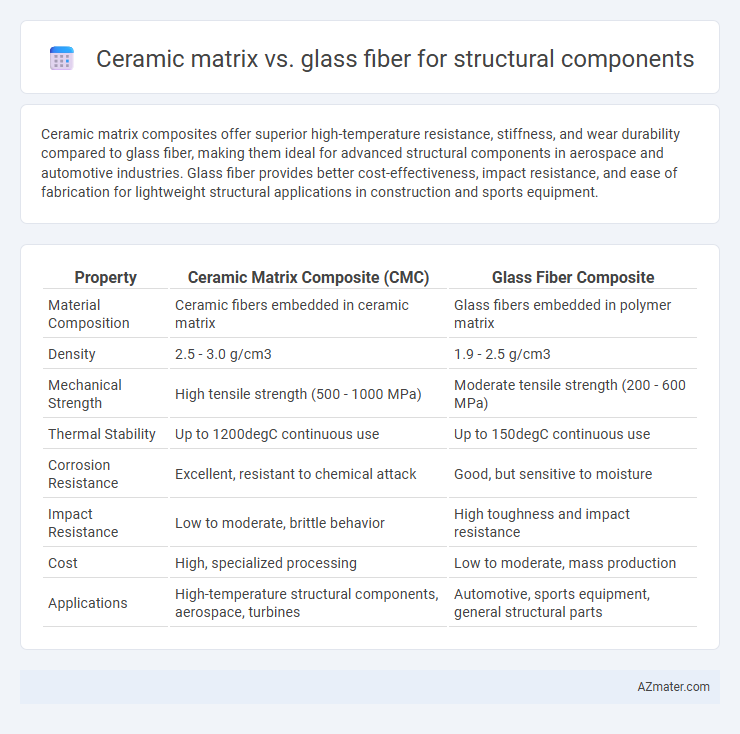Ceramic matrix composites offer superior high-temperature resistance, stiffness, and wear durability compared to glass fiber, making them ideal for advanced structural components in aerospace and automotive industries. Glass fiber provides better cost-effectiveness, impact resistance, and ease of fabrication for lightweight structural applications in construction and sports equipment.
Table of Comparison
| Property | Ceramic Matrix Composite (CMC) | Glass Fiber Composite |
|---|---|---|
| Material Composition | Ceramic fibers embedded in ceramic matrix | Glass fibers embedded in polymer matrix |
| Density | 2.5 - 3.0 g/cm3 | 1.9 - 2.5 g/cm3 |
| Mechanical Strength | High tensile strength (500 - 1000 MPa) | Moderate tensile strength (200 - 600 MPa) |
| Thermal Stability | Up to 1200degC continuous use | Up to 150degC continuous use |
| Corrosion Resistance | Excellent, resistant to chemical attack | Good, but sensitive to moisture |
| Impact Resistance | Low to moderate, brittle behavior | High toughness and impact resistance |
| Cost | High, specialized processing | Low to moderate, mass production |
| Applications | High-temperature structural components, aerospace, turbines | Automotive, sports equipment, general structural parts |
Introduction to Structural Components
Ceramic matrix composites (CMCs) offer superior high-temperature resistance and stiffness compared to glass fiber composites, making them ideal for structural components exposed to extreme environments. Glass fiber reinforced polymers (GFRPs) provide excellent tensile strength, lightweight characteristics, and cost-effectiveness, suitable for general structural applications with moderate load requirements. Selecting between ceramic matrix and glass fiber composites depends on the specific mechanical performance, thermal endurance, and durability needs of the structural component.
Overview of Ceramic Matrix Composites
Ceramic matrix composites (CMCs) offer superior high-temperature resistance and excellent mechanical strength compared to glass fiber composites, making them ideal for demanding structural components in aerospace and automotive industries. CMCs consist of ceramic fibers embedded in a ceramic matrix, providing enhanced fracture toughness and thermal stability, unlike glass fiber composites which are limited by lower temperature thresholds and reduced stiffness. The advanced microstructure of CMCs enables improved damage tolerance and longer service life in harsh environments, outperforming traditional glass fiber materials under extreme stress and thermal cycling conditions.
Overview of Glass Fiber Composites
Glass fiber composites consist of fine glass fibers embedded in a polymer matrix, offering high tensile strength, excellent flexibility, and good impact resistance, making them ideal for structural components in automotive, aerospace, and construction industries. Their low density and corrosion resistance provide a lightweight yet durable solution compared to ceramic matrix composites, which excel in high-temperature and wear resistance but often suffer from brittleness. Glass fiber composites enable efficient energy absorption and can be manufactured cost-effectively, supporting widespread use in structural applications requiring a balance of strength and toughness.
Mechanical Strength Comparison
Ceramic matrix composites (CMCs) exhibit superior mechanical strength compared to glass fiber composites, offering higher stiffness, hardness, and resistance to wear under high-temperature conditions. Glass fiber composites provide good tensile strength and impact resistance but generally fall short in load-bearing capacity and fracture toughness when subjected to extreme mechanical stress. The enhanced microstructural integrity of ceramic matrices results in improved durability and structural performance critical for aerospace and automotive applications.
Thermal Resistance and Performance
Ceramic matrix composites exhibit superior thermal resistance, maintaining structural integrity at temperatures exceeding 1200degC, making them ideal for high-temperature applications. Glass fiber composites, while cost-effective and lightweight, generally withstand temperatures up to 500degC before degradation occurs. The enhanced thermal performance of ceramic matrices enables prolonged durability and reliability in extreme thermal environments compared to glass fiber counterparts.
Durability and Longevity
Ceramic matrix composites exhibit superior durability and longevity compared to glass fiber due to their high resistance to wear, corrosion, and high-temperature environments. Glass fiber tends to degrade faster under prolonged exposure to moisture and UV radiation, reducing its structural integrity over time. The inherent thermal stability and fracture toughness of ceramic matrices make them highly suitable for long-term structural applications in demanding conditions.
Weight and Density Considerations
Ceramic matrix composites offer significantly lower density compared to traditional metal components, typically ranging from 2.5 to 3.2 g/cm3, whereas glass fiber-reinforced polymers usually have densities around 1.8 to 2.0 g/cm3, making glass fiber generally lighter. However, ceramic matrices provide superior stiffness and high-temperature resistance despite their higher weight relative to glass fiber composites. Designers must balance the lower density and weight benefits of glass fiber with the enhanced mechanical and thermal properties of ceramic matrix composites for structural component applications.
Manufacturing Processes and Costs
Ceramic matrix composites undergo complex manufacturing processes such as chemical vapor infiltration and hot pressing, resulting in higher production costs but superior high-temperature resistance and stiffness. Glass fiber composites are produced through more cost-effective methods like filament winding and resin transfer molding, offering lower material and fabrication expenses with adequate structural performance. The choice between ceramic matrix and glass fiber composites depends on balancing manufacturing complexity, cost efficiency, and specific structural requirements.
Applications in Industry
Ceramic matrix composites (CMCs) excel in high-temperature structural components in aerospace and automotive industries due to their superior thermal stability, wear resistance, and lightweight properties. Glass fiber reinforced polymers (GFRP) dominate in construction and marine applications by offering exceptional tensile strength, corrosion resistance, and cost-effectiveness. The choice between CMCs and GFRP hinges on specific environmental conditions, load requirements, and budget constraints within industrial sectors.
Future Trends and Innovations
Ceramic matrix composites (CMCs) are gaining prominence in structural components due to their superior high-temperature resistance, enhanced toughness, and reduced weight compared to traditional glass fiber materials. Innovations in nanotechnology and hybrid composite structures are driving the development of multifunctional ceramics with improved damage tolerance and thermal stability. The integration of additive manufacturing techniques promises to optimize microstructural design, enabling future structural components with tailored mechanical performance and extended service life.

Infographic: Ceramic matrix vs Glass fiber for Structural component
 azmater.com
azmater.com